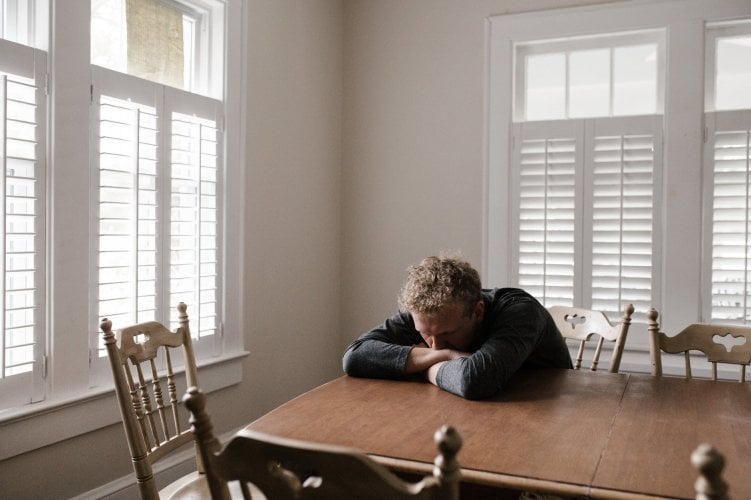Broken Rituals

By: Rev. Peter Keady, First Responder Chaplain
Rituals don’t have to have spiritual connotations. Everyone has rituals they follow every day. The time we get up, the robe we wear or don’t wear to the bathroom, brushing our teeth, making coffee, eating breakfast — they’re all part of our morning ritual.
It was the day after a big holiday, I was exhausted and could barely get out of bed. It wasn’t because we had a house full of people nor was it due to running from home-to-home visiting friends and relatives. I didn’t have Covid nor the flu. Like most people, my wife and I celebrated the day at home quietly. We made a special meal for just the two of us – celebrating the holiday much differently than in the past.
So, why the day-after crash? It was perplexing to me. It was through social media that I learned many people were experiencing the same thing. Their holiday celebrations were scaled back, too, but they felt the same debilitating exhaustion.
What could be causing this wide-spread fatigue?
In my training with stress, trauma, and disasters, I’ve learned a lot about the human psyche and biology; the fight/flight/freeze response, the amygdala and frontal cortex roles in stress, and all the hormone dumps common during and after stress and trauma. But why would a calm day be followed by a time typically reserved for recuperating from an MMA octagon death match? I have a theory and it is just as much psychological as physiological.
We are intricately intertwined as human beings, communally and individually. However, in our western approach to medicine and living, we’ve come to compartmentalize most of our lives. Work. Home. Love. Friendships. They all fit nice and neatly into our mental boxes, just like the tools in our fire apparatus, a place for everything and everything in its place. Even as Kindergartners we’re taught to keep things in our cubbies for neat, easy access. But the human body, mind, and spirit are indivisible; although we talk about them separately, they are connected at a level most of us, because of our upbringing, don’t consider.
How could a person be made up of several parts but be a single whole? Perplexing!
What happened to me was a physical manifestation of a psychological release. Over the past ten months, the pandemic and all the reactions to it, regardless of whether appropriate or helpful, stole a ton of things away from us that we might have taken for granted. Everything from how and when we went food shopping to how and when we grieved for deceased loved ones. Birthday parties, anniversaries, and graduations all had to be reformatted to fit the Covid guidelines, those ever-changing guidelines. In some of this, there were pleasant challenges and even a birthing of better ways of doing things. But in it all, even in the kind of toilet paper we purchased, there were breaks in the patterns we developed. Some patterns were decades old, passed down from one generation to the next. These were broken rituals and the loss of them had a greater impact on us than we might think.
Rituals don’t have to have spiritual connotations. Everyone has rituals they follow every day. The time we get up, the robe we wear or don’t wear to the bathroom, brushing our teeth, making coffee, eating breakfast — they’re all part of our morning ritual. If we think about this long enough, we’ll find rituals are peppered throughout our days, weeks, and months.
So, why did I struggle so immensely without any notable exertion? My theory is that the slump was a physical manifestation of an emotional expression of relief.
Broken rituals take a toll on us. If our morning ritual is disrupted for a day or even a few by our “lovely” relatives hogging the bathroom and drinking all the coffee creamer during their unexpected visit, we can adjust and tolerate it for a short while. But if it goes on too long, it won’t be pretty. Now, suppose not just one ritual but every ritual or pattern we’re accustomed to is disrupted. And not just for a day, but for many weeks at a time. What do you think happens to us?
For most of us, we’ve adjusted, discovering a new equilibrium and balance in the disruption. I liken it to finding our sea legs. Whenever I go ocean fishing it takes me a bit to acclimate to the rocking and rolling of the boat. It’s a challenge at first, especially if I haven’t been out for a while, but eventually I get it.
All of this is important – especially for first responders. Rituals and patterns are part of the first responder’s every-day work cycle. In my experience working with fire, police, EMS, and dispatch personnel, having a pattern to the day is very valuable. Truck checks, equipment checks, getting dressed in uniform, all add to the daily pattern. It helps you address the ever-present surprises of responding to calls.
So, the potential of you having broken rituals in both your personal and professional lives is extremely high. I’ve spoken to first responders, and they’ve expressed a bewilderment as to why they were so tired for seemingly no reason. I know they’re resilient, as it is part of their DNA. Still, I encourage you to listen to your body. Get rest when you feel tired. Eat well. Exercise and do more than you usually would to care for yourself. Not only are you experiencing the impact of pandemic disruption – you also have the day-to-day stress on your plate.
Listen to your body!
What does it look like to suffer from traumatic or cumulative stress? For some, they’re more agitated, hyper-vigilant, depressed, or anxious. Physically, some can develop rashes, lose hair, or experience sleep loss. More severe manifestations can include heart palpitations, high blood pressure and general fatigue. It can impact our relationships, spirituality, and world view. The list goes on and on. And even if we’ve managed to accommodate and adjust to the new surroundings imposed on us, we’re still swimming through the pool of stress to get from what used to be to where we want to be. No easy task in constantly swirling waters.
As we find ourselves firmly into 2021, we can’t take lightly the impact broken rituals have on our lives and health. What can we do? Here are a few suggestions.
1. Like any kind of major issue, acknowledging the impact is a helpful start. As the saying goes, the first step in recovery is admitting we have a problem. For us, the first step just might be acknowledging that changes in the ways we used to do things might be hitting us harder than we want to admit.
2. Mourn the loss of the ways you enjoyed. Grief and mourning can be powerful and positive emotions when given the right expression and forum. The way I explain this to others is to give yourself allowance to be upset at the loss of something special. Allow yourself to be human. It’s okay. Rituals and patterns are important and when we lose them, it sucks.
3. After all of this, create some new rituals. For some people and organizations, “This is the way we’ve always done it,” is a mantra needing to be changed. Coming from over twenty-five years in church ministry, this attitude can actually be debilitating to growth and ingenuity. So, utilizing opportunities – even if forced upon us – we can create some new rituals and patterns replacing the old ones, even if temporarily.
As we move through the coming days, we have to keep all of this in mind. We have to practice a level of self-care we might not be used to or comfortable with. Now is the time to force ourselves to listen to our bodies, listen to those around us who care, and take the extra step in caring for ourselves. When we properly tend to ourselves, we can better care for others. Don’t brush off the potential impact a disrupted morning, day, or week might have on your personal and professional performance, and especially your health. Taking the additional and necessary steps to address our shifting culture and navigating the constant change is essential to our health, performance and ultimately, our happiness.
Reverend Peter Keady has been serving First Responder agencies for over seven years. Having twenty years of pastoral ministry experience, he was presented with the opportunity of chaplaincy in serving his local fire department. Discontent with simply ceremonial duties, he sought additional training through the International Critical Incident Stress Foundation, The Federation of Fire Chaplains, and the Police Chaplain Program; now holding advanced certificates in all three organizations. Additionally, he has certification in First Responder Chaplaincy through the Spiritual Care Association and Critical Incident Stress Management from the University of Maryland, Baltimore County. His organization, First Responder Chaplain Corps, currently serves five local fire departments, an EMS agency and two municipal police departments as well as the Pennsylvania State Police. He is a responding member of the Eastern Pennsylvania Regional CISM Team. He is the Founder and President of First Responder Chaplain Corps which seeks to develop and support First Responder chaplaincies in willing agencies. He has multiple certifications in CISM, suicide engagement, First Responder trauma, disaster response, and spiritual care. You can learn more about Chaplain Keady and First Responder Chaplain Corps at www.FirstResponderCC.com
Photo by Andrew Neel
Podcast
Contests & Promotions
















